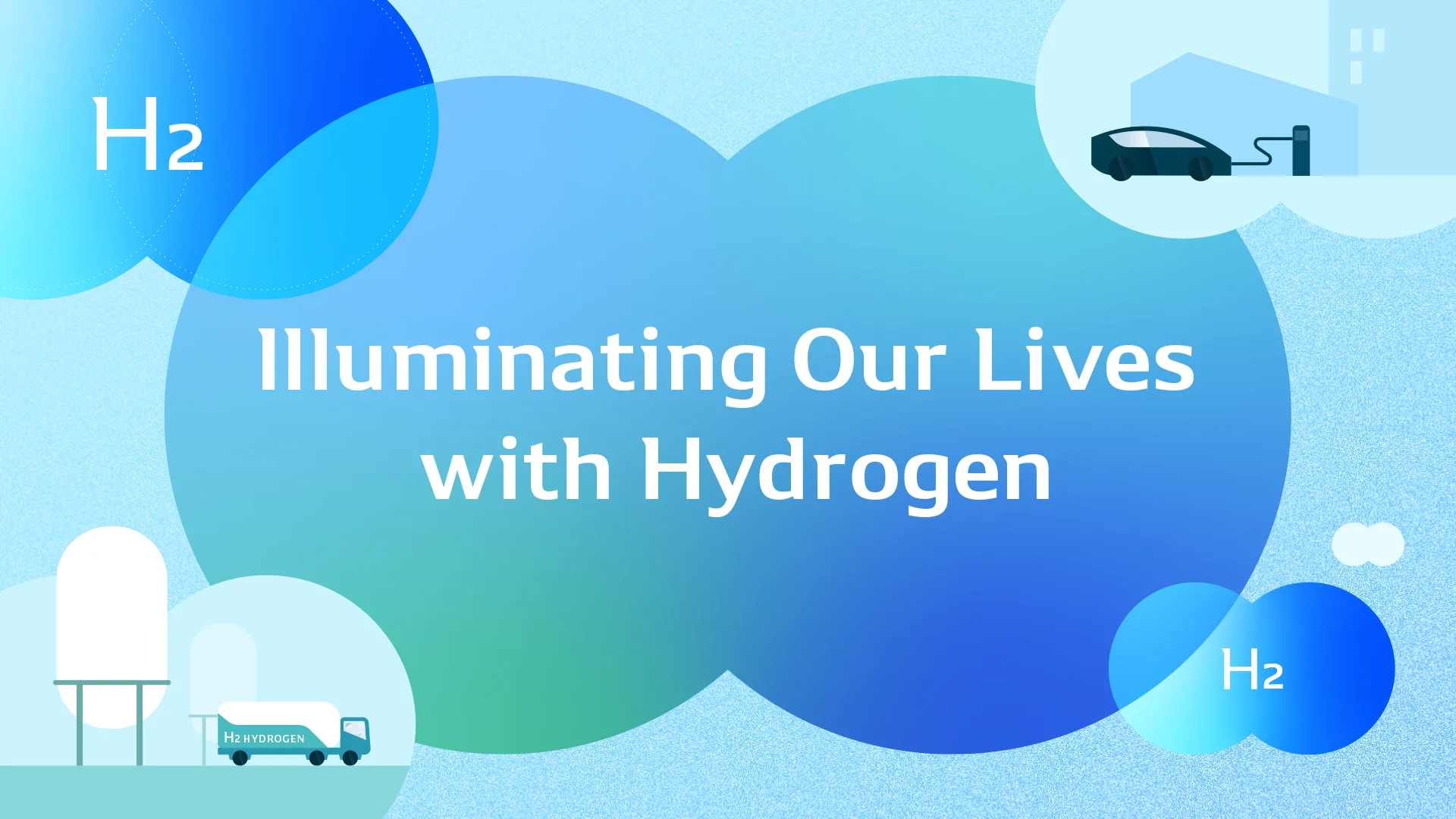

Aug 31, 2023
VISION & IDEAHydrogen Energy 101: Experts Explain!Let's Talk Hydrogen
Let's Talk Hydrogen
Hydrogen has captured the spotlight in recent years as a compelling next-generation energy contender. Deemed the rising star of clean energy for the future, hydrogen releases zero CO₂ emissions when burned as fuel. The sources for its production are as varied as they are abundant, including not only water but also gas and coal, while its energy content is so immense it propels rockets skyward.

The significant potential encapsulated within hydrogen has set the wheels in motion, accelerating experiments with hydrogen-based energy systems. However, the quest towards harnessing the full potential of this resource is not without obstacles, particularly when it concerns the refinement of technology and reduction of costs.
Why exactly is hydrogen energy attracting this much attention?
How can we unlock more practical applications for this technology and build a hydrogen-powered society?
To help us shed some light on these questions, we invited two specialists in the field: renowned hydrogen expert Professor Kazunari Sasaki, Director of the International Research Center for Hydrogen Energy at Kyushu University, and Jiro Ebihara, a senior executive officer at hydrogen energy advocate DENSO Corporation. Together, we delve deep into the topic of hydrogen, from the very fundamental aspects of this extraordinary element to the key catalysts propelling the creation of a hydrogen-powered society.

Contents of this article
Hydrogen Essentials: Production, Storage & Transportation, Usage
──Let's start with the basics: what makes hydrogen such an interesting form of energy?
Sasaki Hydrogen is the most abundant element in the universe. On Earth, it is found in combination with other elements, existing in various compounds such as water and coal.

The most notable characteristic of hydrogen, I would say, is that it doesn’t emit any CO₂ when burnt.
During combustion, hydrogen (H₂) reacts chemically with oxygen (O₂), but the only by-product of the reaction is water (H₂O), as carbon (C) is not part of hydrogen’s composition in the first place. What’s more is that the chemical reaction releases so much energy that hydrogen is even used as a propellant for space rockets.

From a technical perspective, hydrogen is considered secondary energy. This point is often overlooked, but it is an important one to note when learning about the element.
First of all, there is “primary energy”, which refers to energy derived from natural sources, such as solar and wind, and fossil fuels like oil, natural gas, and coal. And then there is secondary energy, which is energy that is processed and converted from primary energy into a usable form for society, such as electricity or heat. In other words, hydrogen is energy that can be produced.

Hydrogen can also be stored.
Electricity and heat are the common forms of secondary energy used in daily life today. However, they’re not that easy to store. Electricity can be stored in a battery, but its capacity is limited. Water will stay hot in a bath for a limited time, but it too, will turn cold by the next morning. Since storing electricity and heat is so difficult, both need to be produced in a constant cycle.
Enter hydrogen. Hydrogen can be pre-produced, stored away, and then used exactly as and when required. It can serve as a backup power source during power failures caused by disasters. It can also be pre-produced overseas using lower-cost feedstocks and then transported to Japan for actual use. Historically, resource-scarce Japan has faced hardships in energy procurement—however, hydrogen can help us establish greater energy security by means of a more robust energy supply.
And finally, perhaps the biggest advantage of hydrogen is the fact that it doesn’t produce CO₂.
And just like that, we’ve analyzed the three key points associated with the element—Production, Storage & Transportation, and Usage. We’re now off to a good start to understanding the remarkable attractiveness of hydrogen.

──On the flip side, using hydrogen also comes with various challenges, doesn’t it? For example, costs and the production process.
Sasaki That’s true. If we use fossil fuels like natural gas and coal to produce hydrogen, for example, we will end up generating some CO₂ emissions as part of the process, no matter what. This is the reason why we should pay attention to what we use to make it. Depending on the production method itself, we can divide hydrogen into grey, blue, or green.
Grey hydrogen is produced by extracting it from fossil fuels. This process also generates CO₂ emissions, which are simply discharged into the atmosphere. Although grey hydrogen itself doesn’t release any CO₂ when used, its production process forms carbon footprints that weigh on the environment.
Blue hydrogen, meanwhile, is made using methods that reduce the amount of CO₂ released into the atmosphere. This is typically done by capturing the CO₂ emitted during the production process and sequestering the gas underground, and then also repurposing it as a feedstock or fuel source.
Lastly, we have green hydrogen. This is hydrogen produced by electrolyzing water using power generated from renewable energy sources, such as solar and wind. Thus, its entire production process doesn’t generate any CO₂.

Our current priority is to produce green hydrogen efficiently and use it effectively.
Various companies are already performing tests that have the potential to transform our carbon-centric society’s transition into a hydrogen one. However, it’s also true that we need to clear many hurdles—including those in costs and infrastructure—before we’re able to realize more practical applications for hydrogen.
Financial Barriers Gatekeeping Hydrogen
──For DENSO, what are some of the roadblocks encountered so far in your hydrogen tests?
Ebihara It’s exactly as Mr. Sasaki said—we’ve got quite a number of challenges to navigate.
Take the production process for hydrogen, for example, where we need to develop technology that’s not only highly efficient but also clean. On top of that, we also must think about building the necessary infrastructure for storing hydrogen and also consider ways to transport it.

That said, even if we do find ways to transport hydrogen cheaply, hydrogen transportation businesses can’t possibly last without hydrogen power being widely adopted, whether it’s for fuel cell vehicles, power generation, or industrial applications.

Therefore, while this implies that the entire supply chain will need restructuring, they also signal many financial hurdles that companies will have to confront and overcome.
Sasaki The cost factor is a big challenge, isn’t it? And this issue isn’t exclusive to hydrogen. Costs are always high whenever an innovative product is first launched, because there isn’t a supporting supply chain and infrastructure for it yet. But as the user base grows, supply chains and infrastructure also naturally develop and solidify. This paves the way for a cheaper product that can be supplied in larger quantities.
In that sense, while initial costs may be high, there cannot be a future without new initiatives. We really have a chicken-and-egg situation on our hands.
Ultimately, while I certainly think government policies and public support are indispensable to reducing upfront costs, we also need to have as many companies as possible carrying out tests at the same time.
Developing Technologies to Produce, Store, Transport, and Use Hydrogen
──Let’s discuss testing specifics. What kind of tests are in progress at DENSO?
Ebihara We’re working on developing technologies that will help build a hydrogen supply chain, specifically in the areas of the production, storage, transportation, and usage of hydrogen.
In terms of production, we’re developing a next-generation solid oxide electrolyzer cell (SOEC) system. This system produces hydrogen by, as the name suggests, electrolyzing water, and is powered by renewable energy generated by solar and wind power facilities installed directly on our premises.

Looking at storage and transport, we are focused on trimming costs in this area. To do that, we’re dedicating resources to local production of hydrogen for its local consumption. To put it simply, we will be producing our own hydrogen for our own use. DENSO Fukushima is currently working with Toyota and other partners on demonstration tests in this field.
For the last part of the process, hydrogen usage, DENSO has helped develop and mass-produce system components for the hydrogen-powered Toyota Mirai, the world’s first fuel cell vehicle. With these mobility-related projects under our belt, we are now aiming to apply this knowledge to other fields as well.

On the other hand, it will take the technologies and expertise of many companies—not just DENSO—to create a hydrogen-powered society. We’ll be working together with our partners as we move to take on more challenges, as this is honestly too great of a task to be tackled by any one company alone.
Sasaki We need to find more real-world applications for hydrogen—otherwise, the demand for it will never increase. So I’m definitely hoping the situation will change with the help of more corporate initiatives.
I think the next step will be to move into the commercial vehicle segment. Hydrogen is expected to gain traction here from around the mid-2020s, I would say.

After commercial vehicles, it’d be power generation: here, Japan’s Strategic Energy Plan has already set a target for hydrogen to account for 1% of the country’s energy mix by 2030.
Once the usage of hydrogen has been established in fossil fuel-reliant fields like chemical and steel-making industries, carbon neutrality will seem much more realisitc.
Ebihara On the other hand, during the transitionary phase towards carbon neutrality, replacing fossil fuels with hydrogen fully all at once may not be economically practical or convenient in some cases. It’ll be important to apply a variety of technological solutions to at least avoid increasing our emissions output. These solutions may involve capturing CO₂ emitted by fossil fuels, or reusing CO₂ itself, for instance.
At DENSO, we’re now working on developing a solid oxide fuel cell that can generate clean power from hydrogen. During this transitionary phase that I mentioned before, we can also very efficiently generate power from natural gas, a traditional source of power, to reduce our CO₂ emissions.
DENSO has also developed technologies to capture, store, and reuse CO₂, which we plan to utilize alongside other resources at our disposal towards the goal of achieving carbon neutrality. Such carbon capture and utilization technologies can be used in steel production or other industries which could take a while to transition to hydrogen.
Local Production for Local Consumption Going Global
──Looking ahead, what do you believe are the key factors for achieving widespread adoption of hydrogen?
Sasaki There is this common notion that Japanese companies “win in technology but lose in business”—but this pattern must be broken for hydrogen. We can achieve this by ensuring that the public, private, and academic sectors share the common goal of building a hydrogen-powered society.
Japan is currently a step ahead in hydrogen technology. Although the US and European governments have dedicated considerable budgets to popularize hydrogen, such investments will still require some time to bear fruit. On the other hand, Japan already has advanced hydrogen technology—that itself is a huge advantage. This technology is the root of our strength, and with careful efforts to refine and develop it, I believe that Japan could still come out on top in 2050.

Our automotive industry, in particular, has such a powerful technological drive. I’m really excited about what companies like DENSO will do with the globally competitive technologies they have.
Ebihara Thank you for your words of support! At the moment, we’ve only just begun to scratch the surface. Our highest priority is to transform our test initiatives into sustainable and viable businesses, paving the way for more substantial contributions towards a hydrogen-powered society.
To get there, our core technologies in the mobility sector are definitely key. In fact, many technologies developed for internal combustion engines can be adapted and applied to many other fields. There are also plenty of opportunities to leverage ceramic and other material technologies for hydrogen applications. These technologies, for example, can be used to improve the power generation efficiency of the batteries powering fuel cell vehicles.

Also, very importantly, any vehicle needs to be reliable in any environment. Our expertise can be applied to build a hydrogen energy infrastructure that ensures safe use.
Establishing a profitable business based on new technologies is a challenging task, but I’m convinced that with DENSO’s technological expertise brought over from the automotive sector, we can not only reduce costs but also grow demand.

──Are there any specific challenges DENSO wants to tackle in the pursuit of a hydrogen-powered society?
Ebihara We’d like to globalize the Local Production for Local Consumption model. Earlier on, I mentioned that DENSO is working on creating a system for “local energy”, where hydrogen produced locally is consumed locally. The demonstration project at DENSO Fukushima takes us one step closer in that direction, with a particular focus on developing technologies that help even small companies harness the power of local energy. Imagine a technology for producing hydrogen on a small scale, storing it, and then supplying it locally whenever it’s needed. This would ensure access to a stable energy source without waste for each area that needs it.
Needless to say, there are other companies with a proven track record in technologies for large-scale power plants and infrastructure. What we have is our expertise in mobility technology that we can use to build a circular system for energy tailored to usage within a more compact range. To achieve that, we’re aiming to work together with various companies and experts, including Professor Sasaki, to chart a course for the future.

Using DENSO Fukushima as our launchpad, we’ll replicate the model in global operations, making our own contribution toward society’s transition to carbon neutrality. This is DENSO’s next endeavor, and the future we’ve set our eyes on.
Writer: Yuka Tsukada
Photographer: Toshiharu Takei
Designer: Risa Yoshiyama
Editor: Fumiya Kimiwada
This article is based on a Japanese article produced by NewsPicks Brand Design and published by DENSO with permission.
REACTION
Changing your "Can'ts" into "Cans"
Where Knowledge and People Gather.



Leave a comment